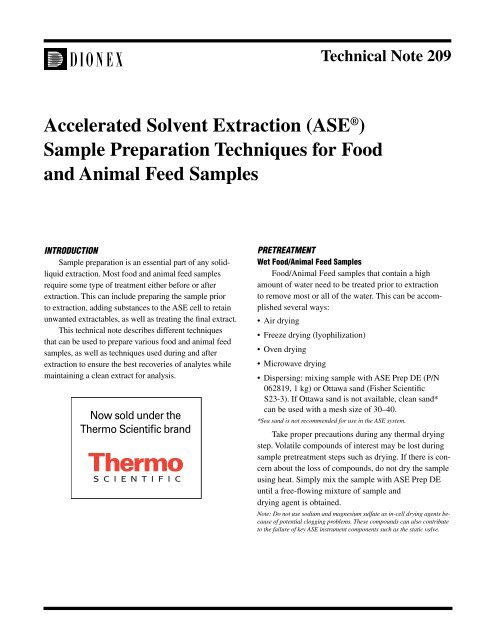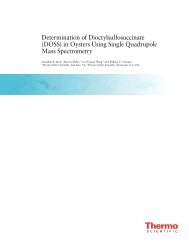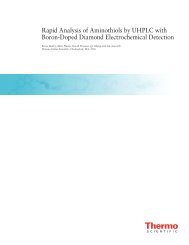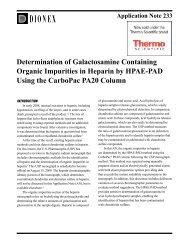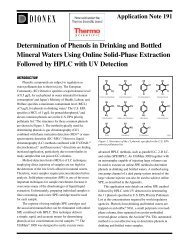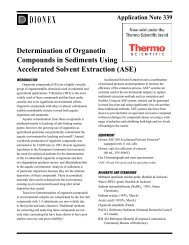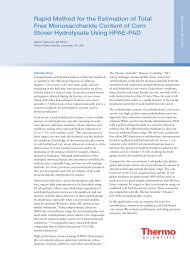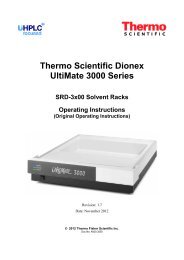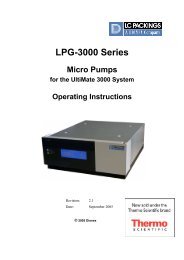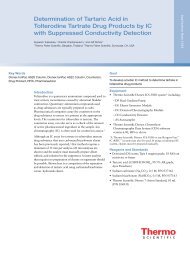Accelerated Solvent Extraction (ASE) Sample Preparation ... - Dionex
Accelerated Solvent Extraction (ASE) Sample Preparation ... - Dionex
Accelerated Solvent Extraction (ASE) Sample Preparation ... - Dionex
You also want an ePaper? Increase the reach of your titles
YUMPU automatically turns print PDFs into web optimized ePapers that Google loves.
<strong>Accelerated</strong> <strong>Solvent</strong> <strong>Extraction</strong> (<strong>ASE</strong> ® )<br />
<strong>Sample</strong> <strong>Preparation</strong> Techniques for Food<br />
and Animal Feed <strong>Sample</strong>s<br />
INTRODUCTION<br />
<strong>Sample</strong> preparation is an essential part of any solidliquid<br />
extraction. Most food and animal feed samples<br />
require some type of treatment either before or after<br />
extraction. This can include preparing the sample prior<br />
to extraction, adding substances to the <strong>ASE</strong> cell to retain<br />
unwanted extractables, as well as treating the final extract.<br />
This technical note describes different techniques<br />
that can be used to prepare various food and animal feed<br />
samples, as well as techniques used during and after<br />
extraction to ensure the best recoveries of analytes while<br />
maintaining a clean extract for analysis.<br />
Technical Note 209<br />
PReTReaTmeNT<br />
Wet Food/Animal Feed <strong>Sample</strong>s<br />
Food/Animal Feed samples that contain a high<br />
amount of water need to be treated prior to extraction<br />
to remove most or all of the water. This can be accomplished<br />
several ways:<br />
• Air drying<br />
• Freeze drying (lyophilization)<br />
• Oven drying<br />
• Microwave drying<br />
• Dispersing: mixing sample with <strong>ASE</strong> Prep DE (P/N<br />
0628 9, kg) or Ottawa sand (Fisher Scientific<br />
S23-3). If Ottawa sand is not available, clean sand*<br />
can be used with a mesh size of 30–40.<br />
*Sea sand is not recommended for use in the <strong>ASE</strong> system.<br />
Take proper precautions during any thermal drying<br />
step. Volatile compounds of interest may be lost during<br />
sample pretreatment steps such as drying. If there is concern<br />
about the loss of compounds, do not dry the sample<br />
using heat. Simply mix the sample with <strong>ASE</strong> Prep DE<br />
until a free-flowing mixture of sample and<br />
drying agent is obtained.<br />
Note: Do not use sodium and magnesium sulfate as in-cell drying agents because<br />
of potential clogging problems. These compounds can also contribute<br />
to the failure of key <strong>ASE</strong> instrument components such as the static valve.<br />
Technical Note 209
PlaNT maTeRIal<br />
Plant material can contain a varying degree of<br />
moisture and often requires treatment prior to extraction.<br />
Lyophilization is an excellent pretreatment method for<br />
plant materials because this process yields a fine, dry<br />
sample that can be easily loaded into an <strong>ASE</strong> extraction<br />
cell. However, if freeze-drying is not a viable option,<br />
simply grind (or mix) the plant material with <strong>ASE</strong> Prep<br />
DE using a mortar and pestle. Initially, a ratio of plant<br />
material to DE of : is a good mixture, but the amount<br />
of DE may need to be increased if the plant material is<br />
very wet. Sufficient DE has been mixed with the sample<br />
if the sample can be easily removed from the mortar<br />
without adhering to the sides of the mortar. If the plant<br />
material is low in moisture, it can be ground in a blender<br />
or mill to produce small particles (
ChOOsINg a FIlTeR<br />
It is very important to use a filter in the bottom of<br />
the extraction cell. This will keep fine sample particulates<br />
from getting trapped in the frit or from leaving the<br />
cell and possibly causing damage to the static valve.<br />
Cellulose filters (for <strong>ASE</strong> 200, <strong>Dionex</strong> P/N 049458, pkg.<br />
of 00 and for <strong>ASE</strong> 300 and 00, <strong>Dionex</strong> P/N 056780,<br />
pkg. of 00) are the most common filters used, but if<br />
the extraction solvent chosen is an aqueous solvent and<br />
the temperature is above 00 °C, then the cellulose filter<br />
should not be used. Glass-fiber filters (for <strong>ASE</strong> 200,<br />
<strong>Dionex</strong> P/N 0470 7, pkg. of 00, and for <strong>ASE</strong> 300 and<br />
00, <strong>Dionex</strong> P/N 05678 , pkg. of 00) are available for<br />
these applications. The glass-fiber filters are available in<br />
the same diameter sizes as the cellulose filters. If the<br />
sample contains very fine particulates and there is<br />
evidence of these particulates passing through into the<br />
extraction vial, more than one filter (glass fiber or cellulose)<br />
can be used in the extraction cell to help eliminate<br />
this problem. In most cases, 2–3 filters will be sufficient.<br />
IN-Cell CleaN UP<br />
In an effort to eliminate post-extraction clean-up<br />
steps, <strong>Dionex</strong> has studied the addition of various sorbents<br />
to the extraction cell. For many sample types, this approach<br />
has proven successful in producing clean extracts<br />
that are ready for direct analysis. For example, lipids<br />
are often co-extracted with fish tissue. Adding alumina<br />
(aluminum oxide, Al O , acidic, activated by oven drying<br />
2 3<br />
at 350 °C for 5 min) to the extraction cell before adding<br />
the sample or sample mixture prevents the extraction of<br />
unwanted lipids. Mixing the sample with C 8 resin ( :2)<br />
retains organic contaminants (C 8 bonded silica, 35–70<br />
µm diameter and porosity of 60 Å from Alltech has been<br />
used, but similar material from any vendor can be used).<br />
When performing in-cell clean up, solvent choice<br />
can impact the retention of unwanted components. For<br />
example, a mixture of hexane/acetone ( : ) is a common<br />
solvent choice for extracting organochlorine pesticides<br />
from animal tissues. However, after extraction, a cleanup<br />
step is usually required to remove co-extracted lipids.<br />
If alumina is placed in the outlet (or exit) end of the extraction<br />
cell (the tissue sample that has been thoroughly<br />
mixed with <strong>ASE</strong> Prep DE is placed on top of the alumina),<br />
and hexane is used as the extraction solvent, the<br />
lipids will be retained on the alumina and remain in the<br />
extraction cell. On the other hand, if hexane/acetone ( : )<br />
is used as the extraction solvent, almost no lipid material<br />
will be retained on the alumina. Generally, 60–70 mg of<br />
lipid material can be retained per gram of alumina.<br />
For example, suppose a 0-g sample of fish tissue<br />
that is approximately 0% lipid by weight ( 000 mg<br />
of total lipids) needs to be extracted. The amount of<br />
alumina necessary to retain all of the lipids from this<br />
sample is 000 mg lipid/60 mg alumina (mg lipid) - or<br />
approximately 7 g of alumina ( 6.67 g). In this case a<br />
33-mL <strong>ASE</strong> cell or larger would be required to contain<br />
the fish tissue, the <strong>ASE</strong> Prep DE, and the necessary<br />
volume of alumina.<br />
Another procedure that has been used to eliminate<br />
lipids is to put the collected extract in a refrigerator or<br />
freezer. Any collected lipids will turn solid and the<br />
liquid extract can be carefully decanted or the vial can<br />
be centrifuged.<br />
ChOOsINg a sOlveNT<br />
When transferring extraction methods from traditional<br />
or manual techniques to <strong>ASE</strong>, the question, “What<br />
solvent should I use?” often arises. In most cases, the<br />
same solvent that was used in the previous technique can<br />
be used in the <strong>ASE</strong> system with excellent results. Remember<br />
that the <strong>ASE</strong> system is compatible with almost<br />
all liquid solvents with the exception of mineral acids<br />
(HCl, H SO , and HNO ) and strong caustic<br />
2 4 3<br />
solutions (KOH and NaOH). The use of mineral acids<br />
in the <strong>ASE</strong> system will etch the stainless steel cells and<br />
tubing, which leads to premature failure of key instrument<br />
components. Strong bases destroy the <strong>ASE</strong> pump<br />
components, leading to pump failure. As stated in the<br />
<strong>ASE</strong> User’s Manual, buffers, weak acids, and weak<br />
bases have all been successfully employed as <strong>ASE</strong><br />
solvents. If acidic extraction conditions are required,<br />
weaker acids, such as acetic or phosphoric should be<br />
used, usually in the – 0% (v/v) range mixed with<br />
aqueous or polar solvents.<br />
If there is uncertainty about which solvent to use,<br />
note that the polarity of the extraction solvent should be<br />
similar to the polarity of the target analytes. The solvent<br />
should not only be able to extract the analytes but leave<br />
the sample matrix generally intact. For example, when<br />
the goal is to extract an analyte that is moderately polar<br />
using an extremely polar solvent, the polar solvent may<br />
extract not only the target analytes, but much of the<br />
sample matrix as well. This scenario could create an<br />
extract that contains co-extractable compounds that may<br />
require extensive clean-up procedures prior to analy-<br />
Technical Note 209 3
sis—or cause damage to an expensive piece of analytical<br />
instrumentation. To eliminate this concern, a less polar<br />
extraction solvent or a mixture of solvents may work<br />
better. Generally, if a particular solvent has worked well<br />
for a traditional extraction procedure, it should also work<br />
well for <strong>ASE</strong>. Mixing solvents of different polarities can<br />
be used to extract a broad range of target compounds<br />
present in the same sample. <strong>Solvent</strong> choice may also<br />
depend on which solvent is compatible with the chosen<br />
analytical technique. Most liquid solvents, including<br />
water and buffered aqueous mixtures, can be used in the<br />
<strong>ASE</strong> instrument.<br />
Table lists some suggested <strong>ASE</strong> solvents for various<br />
food matrices and analytes. Please note that these are<br />
Matrix Analytes Group Suggested <strong>Solvent</strong>s<br />
Fruits and vegetables Environmental toxins (organic) a DCM/acetone (1:1, v:v), hexane/acetone (1:1, v:v), toluene, ethyl acetate<br />
Fruits and vegetables Environmental toxins (inorganic) b Water<br />
Fruits and vegetables Antioxidants 7% acetic acid in methanol, 0.1% TFA in methanol<br />
Grains and seeds Oils Hexane, hexane/isopropanol (3:2, v:v), petroleum ether<br />
Grains and seeds Pesticides DCM/acetone (1:1, v:v), hexane/acetone (1:1, v:v), toluene, ethyl acetate<br />
Grains and seeds Mycotoxins Methanol/water (1:1, v:v), acetonitrile/water (1:1, v:v),<br />
methanol/water/ H3PO4<br />
Meats (beef, pork and poultry) Pesticides Acetone/hexane (1:1, v:v), DCM/acetone (1:1, v:v)<br />
Meats (beef, pork and poultry) Sterols Chloroform/methanol (2:1, v:v), hexane /isopropanol (3:2, v:v)<br />
Meats (beef, pork and poultry) Ions: sulfates and nitrates Water<br />
Meats (beef, pork and poultry) Antibiotics Water<br />
Fish and shellfish Environmental toxins (organic) DCM/acetone (1:1, v:v), hexane/acetone (1:1, v:v), toluene<br />
Fish and shellfish Environmental toxins (inorganic) Methanol, methanol with 1% acetic acid<br />
Dairy Environmental toxins (organic) DCM/acetone (1:1, v:v), hexane/acetone (1:1, v:v)<br />
Dairy Environmental toxins (inorganic) Water<br />
Dairy Fats and lipids Hexane, hexane/isopropanol (3:2, v:v), petroleum ether<br />
Snack foods Fats and lipids Hexane, hexane/isopropanol (3:2, v:v), petroleum ether<br />
Snack foods and potatoes Acrylamide Water with 10 mM formic acid or acetonitrile (100%)<br />
a PAH, PCB, OCP, OPP, Dioxins<br />
b Anions and cations<br />
only suggestions and other solvents or solvent mixtures<br />
may work better for particular samples. In <strong>ASE</strong> method<br />
development, the extraction temperature and choice of<br />
solvent are the most important parameters to consider.<br />
As mentioned previously, if an extraction procedure for<br />
a particular sample already exists, then begin by using<br />
the same solvent in the <strong>ASE</strong> instrument. In some cases,<br />
the choice of solvent will be determined by the analytical<br />
procedure. For example, when extracting polycyclic<br />
aromatic hydrocarbons (PAHs) for GC or GC-MS analysis,<br />
dichloromethane (DCM)/acetone ( : ) is the recommended<br />
<strong>ASE</strong> extraction solvent. However, if HPLC<br />
is the preferred analytical technique, acetonitrile is the<br />
recommended <strong>ASE</strong> solvent.<br />
TABLE 1. SUGGESTED <strong>ASE</strong> SOLVENTS FOR VARIOUS FOOD MATRICES AND ANALYTES<br />
4 <strong>Accelerated</strong> <strong>Solvent</strong> <strong>Extraction</strong> (<strong>ASE</strong>) <strong>Sample</strong> <strong>Preparation</strong> Techniques for Food and Animal Feed <strong>Sample</strong>s
ChOOsINg The ase meThOD PaRameTeRs<br />
<strong>Dionex</strong> has published several application notes<br />
describing extraction of various food and animal feed<br />
samples. These application notes provide recommended<br />
methods and <strong>ASE</strong> parameters for these particular applications.<br />
But, because every sample matrix may be<br />
different and some scenarios may not fit exactly with<br />
each application note, a new method may need to be<br />
developed for some samples.<br />
<strong>Extraction</strong> parameters used in Standard <strong>ASE</strong> Conditions<br />
(SAC) are a good starting point for method development.<br />
To load the SAC method parameters, select<br />
Method “0” in the METHOD EDITOR screen. SAC<br />
conditions are as follows:<br />
Oven Temperature: 00 °C<br />
Static Time: 5 min<br />
Flush Volume: 60 % of cell volumea Purge Time: 60 s on <strong>ASE</strong> 200, 00 s on<br />
<strong>ASE</strong> 300b Static Cycles:<br />
Pressure: 500 psi (only applies to <strong>ASE</strong> 200<br />
instruments)<br />
a Decrease flush volume to 50% if instrument was manufactured in 1998 or later.<br />
b Remember the purge time depends on the <strong>ASE</strong> cell size: 60 s for 11-mL cells<br />
and 100 s for 34-mL cells. Purge time may need to be increased depending on<br />
the size of the <strong>ASE</strong> extraction cell.<br />
Save the SAC conditions as a method number<br />
between and 24 (the instrument will not allow Method<br />
0 to be loaded from the LOAD METHOD/SCHEDULE<br />
Screen). Once the results from the initial <strong>ASE</strong> method<br />
have been determined, adjust the <strong>ASE</strong> method parameters<br />
for optimum extraction recovery for a particular sample.<br />
Remember that the temperature, solvent, and time are the<br />
three most important <strong>ASE</strong> method parameters influencing<br />
extraction efficiency. Changing the extraction temperature<br />
will, in most cases, give the most dramatic results. Once<br />
the extraction temperature has been established, “fine<br />
tune” the <strong>ASE</strong> method by adjusting the static time, the<br />
static cycles, and the flush volume. A finely tuned <strong>ASE</strong><br />
method will result in a fast, efficient extraction that consumes<br />
a minimum volume of solvent. For more information<br />
on <strong>ASE</strong> method development, see <strong>Dionex</strong> Technical<br />
Note 208.<br />
POsT-exTRaCTION TReaTmeNT<br />
Sometimes, in spite of pretreatment efforts, some<br />
type of post-extraction treatment is necessary to produce<br />
high quality analytical data. For example, at <strong>ASE</strong> extraction<br />
temperatures above 00 °C, water from wet samples usually<br />
appears in the final extract, even after pretreatment with<br />
<strong>ASE</strong> Prep DE. If acetone is used as the extraction solvent,<br />
the extracted water will be miscible with the acetone and<br />
may not be visible until the evaporation step (in most cases,<br />
the extract will appear cloudy if water is mixed with acetone).<br />
On the other hand, if hexane is used as the extraction<br />
solvent, the extract will contain two distinct phases: ( ) a<br />
visible water layer, and (2) a hexane layer. To easily remove<br />
unwanted water from extracts, add sodium sulfate directly<br />
to the collection vial containing the extract (remember it is<br />
important not to use sodium sulfate in the extraction cell).<br />
Shake the collection vial and decant the solvent into a clean<br />
collection vial or other suitable container. Rinse the sodium<br />
sulfate with fresh solvent to ensure that analytes of interest<br />
are not trapped in the sodium sulfate layer.<br />
examPle OF meThOD DevelOPmeNT OF aN aNImal<br />
FeeD samPle<br />
The following is an example of developing an <strong>ASE</strong><br />
method for an animal feed sample:<br />
<strong>Sample</strong>: Pelletized rodent food (dry)<br />
Analyte: Anti-schizophrenic drugs<br />
Step One: Pretreatment of sample<br />
• Pellets were ground into a course powder using a hand<br />
grinder.<br />
• 0 g of ground sample was mixed with 5 g of Ottawa<br />
sand (20–30 mesh particle size).<br />
Step Two: <strong>Preparation</strong> of the extraction cell<br />
• A 33-mL <strong>ASE</strong> extraction cell was selected.<br />
• A cellulose filter was placed into the extraction<br />
cell outlet.<br />
• The sample/sand mixture was added to the cell.<br />
Step Three: Selection of <strong>ASE</strong> extraction solvent<br />
• Because methanol was used for the traditional extraction<br />
of this sample (wrist shaker) methanol was also<br />
chosen as the extraction solvent for the <strong>ASE</strong>.<br />
Technical Note 209 5
Step Four: Selection of first <strong>ASE</strong> method parameters<br />
• The temperature of 75 °C was chosen (because of the<br />
high carbohydrate content of the rodent food, a temperature<br />
that was 25 °C below the SAC of 00 °C was<br />
chosen as the preliminary temperature).<br />
• A flush volume of 30% was chosen. (<strong>ASE</strong> instruments<br />
manufactured after 998 contain large-bore tubing.<br />
To adjust for this, the original 60% flush volume was<br />
decreased by half.)<br />
• One static cycle was chosen (SAC).<br />
• A 3-min static time was chosen (3 min was chosen instead<br />
of the SAC of 5 min to cut down on the extraction<br />
time if possible).<br />
• The purge time was chosen to be 00 s (SAC)<br />
• This method was saved as Method .<br />
ResUlTs OF ase meThOD 1<br />
Analysis of the samples extracted using the conditions<br />
of <strong>ASE</strong> Method showed the presence of the target<br />
analyte, but at a lower concentration than desired. From<br />
the initial results of <strong>ASE</strong> Method , methanol appears to<br />
be a good choice for the extraction solvent because the<br />
target analyte was detected. However, the concentration<br />
of the target compound was lower than expected. After an<br />
examination of the extraction parameters of <strong>ASE</strong><br />
Method , it was decided to increase the extraction temperature.<br />
This decision was based on the fact that solvent,<br />
temperature, and extraction time are the three most<br />
important <strong>ASE</strong> method parameters governing extraction<br />
efficiency. A fresh portion of the sample was extracted<br />
using a revised method shown below:<br />
Step Five: Revision of <strong>ASE</strong> Method 1<br />
• Temperature increased to 50 °C (the temperature was<br />
increased due to the low recoveries).<br />
• All other parameters stayed the same.<br />
• Saved new <strong>ASE</strong> parameters as Method 2.<br />
ResUlTs OF ase meThOD 2<br />
Analysis of the samples extracted using the conditions<br />
of <strong>ASE</strong> Method 2 resulted in better recovery of the<br />
target analyte, but the extract was deeply colored and<br />
contained some co-extracted material. It appeared that<br />
the <strong>ASE</strong> extraction temperature was a key parameter for<br />
the extraction of this particular analyte, however, because<br />
some unwanted matrix material was co-extracted with<br />
the target compound, it was thought that perhaps the<br />
extraction temperature in <strong>ASE</strong> Method 2 was too high.<br />
Step Six: Revision of <strong>ASE</strong> Method 2<br />
• Temperature decreased to 00 °C (temperature was<br />
decreased in an effort to eliminate the co-extractables<br />
and to eliminate the dark color of the extract).<br />
• Static time increased to 5 min (static time was increased<br />
to 5 min to ensure good analyte recovery with<br />
a lower temperature).<br />
• All other parameters stayed the same.<br />
• Saved new <strong>ASE</strong> parameters as Method 3.<br />
ResUlTs OF ase meThOD 3<br />
Analysis of the samples extracted using the conditions<br />
of <strong>ASE</strong> Method 3 resulted in excellent recovery of<br />
the target analyte. In addition, the <strong>ASE</strong> extract was clear<br />
and contained no co-extracted matrix material.<br />
sUmmaRy<br />
When developing a method for the <strong>ASE</strong> system,<br />
there are many parameters to consider. First pretreat<br />
the sample, if required, to ensure proper contact with<br />
the extraction solvent. <strong>Sample</strong> pretreatment can be<br />
accomplished in many ways, such as removing excess<br />
water and properly dispersing the sample. Second,<br />
determine the best <strong>ASE</strong> solvent to extract the target<br />
analytes. The solvent that was used for the traditional<br />
or manual extraction method is usually a good starting<br />
point. If needed, adjust or change the <strong>ASE</strong> solvent based<br />
on results from the instrumental or determinative procedure<br />
used to analyze the extract. Third, optimize the<br />
<strong>ASE</strong> method parameters. Standard <strong>ASE</strong> Conditions<br />
(SAC) are typically a good starting point when developing<br />
a new <strong>ASE</strong> method. Finally, determine if any post-<br />
extraction treatment is required, such as removing any<br />
unwanted water from the extract or filtering the extract<br />
prior to analysis.<br />
6 <strong>Accelerated</strong> <strong>Solvent</strong> <strong>Extraction</strong> (<strong>ASE</strong>) <strong>Sample</strong> <strong>Preparation</strong> Techniques for Food and Animal Feed <strong>Sample</strong>s
sUPPlIeRs<br />
Fisher Scientific, 2000 Park Lane, Pittsburgh, PA<br />
5275- 26 USA, Tel: 800-766-7000,<br />
www.fishersci.com.<br />
Alltech Associates, Inc., 205 Waukegan Road,<br />
Deerfield, IL 600 5 USA, Tel: 847-948-8600,<br />
www.alltechweb.com.<br />
ReFeReNCes<br />
. <strong>Extraction</strong> of Drugs from Animal Feeds Using<br />
<strong>Accelerated</strong> <strong>Solvent</strong> <strong>Extraction</strong> (<strong>ASE</strong>). Application<br />
Note 326; <strong>Dionex</strong> Corporation, Sunnyvale, CA.<br />
2. Rapid Determination of Organochlorine Pesticides<br />
in Animal Feed Using <strong>Accelerated</strong> <strong>Solvent</strong> <strong>Extraction</strong><br />
(<strong>ASE</strong>). Application Note 349; <strong>Dionex</strong> Corporation,<br />
Sunnyvale, CA.<br />
3. Rapid Determination of Sulfonamide Residues in<br />
Animal Tissue and Infant Food Containing Animal<br />
Products Using <strong>Accelerated</strong> <strong>Solvent</strong> <strong>Extraction</strong><br />
(<strong>ASE</strong>). Application Note 353; <strong>Dionex</strong> Corporation,<br />
Sunnyvale, CA.<br />
4. Selective <strong>Extraction</strong> of PCBs from Fish Tissue Using<br />
<strong>Accelerated</strong> <strong>Solvent</strong> <strong>Extraction</strong> (<strong>ASE</strong>). Application<br />
Note 322; <strong>Dionex</strong> Corporation, Sunnyvale, CA.<br />
5. Determination of Unbound Fat in Various Food<br />
Matrices Using <strong>Accelerated</strong> <strong>Solvent</strong> <strong>Extraction</strong><br />
(<strong>ASE</strong>). Application Note 32 ; <strong>Dionex</strong> Corporation,<br />
Sunnyvale, CA.<br />
6. <strong>Extraction</strong> of Oil from Oilseeds by <strong>Accelerated</strong> <strong>Solvent</strong><br />
<strong>Extraction</strong> (<strong>ASE</strong>). Application Note 325; <strong>Dionex</strong><br />
Corporation, Sunnyvale, CA.<br />
7. Determination of Total Fat in Powdered Infant<br />
Formula Using <strong>Accelerated</strong> <strong>Solvent</strong> <strong>Extraction</strong><br />
(<strong>ASE</strong>). Application Note 329; <strong>Dionex</strong> Corporation,<br />
Sunnyvale, CA.<br />
Passion. Power. Productivity.<br />
<strong>Dionex</strong> Corporation<br />
1228 Titan Way<br />
P.O. Box 3603<br />
Sunnyvale, CA<br />
94088-3603<br />
(408) 737-0700<br />
North America<br />
Sunnyvale, CA (408) 737-8522 Westmont, IL (630) 789-3660<br />
Houston, TX (281) 847-5652 Atlanta, GA (770) 432-8100<br />
Marlton, NJ (856) 596-0600 Canada (905) 844-9650<br />
www.dionex.com<br />
Europe<br />
Austria (43) 1 616 51 25 Belgium (32) 3 353 4294<br />
Denmark (45) 36 36 90 90 France (33) 1 39 30 01 10<br />
Germany (49) 6126 991 210 Italy (39) 06 66 51 5052<br />
The Netherlands (31) 161 43 43 03<br />
Switzerland (41) 62 205 99 66<br />
United Kingdom (44) 1276 691722<br />
8. <strong>Accelerated</strong> <strong>Solvent</strong> <strong>Extraction</strong> (<strong>ASE</strong>) of Pesticide<br />
Residues in Food Products. Application Note 332;<br />
<strong>Dionex</strong> Corporation, Sunnyvale, CA.<br />
9. Rapid Determination of Fat in Meat Using <strong>Accelerated</strong><br />
<strong>Solvent</strong> <strong>Extraction</strong> (<strong>ASE</strong>). Application Note 334;<br />
<strong>Dionex</strong> Corporation, Sunnyvale, CA.<br />
0. <strong>Accelerated</strong> <strong>Solvent</strong> <strong>Extraction</strong> (<strong>ASE</strong>) of Active<br />
Ingredients from Natural Products. Application Note<br />
335; <strong>Dionex</strong> Corporation, Sunnyvale, CA.<br />
. Determination of Fat in Dried Milk Products Using<br />
<strong>Accelerated</strong> <strong>Solvent</strong> <strong>Extraction</strong> (<strong>ASE</strong>). Application<br />
Note 340; <strong>Dionex</strong> Corporation, Sunnyvale, CA.<br />
2. Determination of PCBs in Large Volume Fish Tissue<br />
<strong>Sample</strong>s Using <strong>Accelerated</strong> <strong>Solvent</strong> <strong>Extraction</strong><br />
(<strong>ASE</strong>). Application Note 342; <strong>Dionex</strong> Corporation,<br />
Sunnyvale, CA.<br />
3. Determination of Pesticides in Large Volume Food<br />
<strong>Sample</strong>s Using <strong>Accelerated</strong> <strong>Solvent</strong> <strong>Extraction</strong><br />
(<strong>ASE</strong>). Application Note 343; <strong>Dionex</strong> Corporation,<br />
Sunnyvale, CA.<br />
4. <strong>Extraction</strong> of Fat from Chocolate Using <strong>Accelerated</strong><br />
<strong>Solvent</strong> <strong>Extraction</strong> (<strong>ASE</strong>). Application Note 344;<br />
<strong>Dionex</strong> Corporation, Sunnyvale, CA.<br />
5. <strong>Extraction</strong> of Fat from Dairy Products (Cheese,<br />
Butter, and Liquid Milks) Using <strong>Accelerated</strong> <strong>Solvent</strong><br />
<strong>Extraction</strong> (<strong>ASE</strong>). Application Note 345; <strong>Dionex</strong><br />
Corporation, Sunnyvale, CA.<br />
6. <strong>Extraction</strong> of Zearalenone from Wheat and Corn by<br />
<strong>Accelerated</strong> <strong>Solvent</strong> <strong>Extraction</strong> (<strong>ASE</strong>). Application<br />
Note 350; <strong>Dionex</strong> Corporation, Sunnyvale, CA.<br />
7. Fast Determination of Acrylamide in Food Using<br />
<strong>ASE</strong>/ICUV or <strong>ASE</strong>/ICMS. Application Note 409;<br />
<strong>Dionex</strong> Corporation, Sunnyvale, CA.<br />
8. Gentili, A., Perret, D., Marchese, S., Sergi, M.,<br />
Olmi, C., Curini, R. <strong>Accelerated</strong> <strong>Solvent</strong> <strong>Extraction</strong><br />
and Confirmatory Analysis of Sulfonamide Residues<br />
in Raw Meat and Infant Foods by Liquid Chromatography<br />
Electrospray Tandem Mass Spectrometry.<br />
J. Agric. Food Chem. 2004, 52, 46 4–4624.<br />
<strong>ASE</strong> is a registered trademark of <strong>Dionex</strong> Corporation.<br />
Asia Pacific<br />
Australia (61) 2 9420 5233 China (852) 2428 3282<br />
India (91) 22 28475235 Japan (81) 6 6885 1213<br />
Korea (82) 2 2653 2580<br />
LPN 1781 PDF 3/06<br />
©2006 <strong>Dionex</strong> Corporation<br />
Technical Note 209 7


